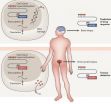(Press-News.org) The research team led by Manel Esteller, director of the Cancer Epigenetics and Biology Program at the Bellvitge Biomedical Research Institute (IDIBELL), professor of genetics at the University of Barcelona and ICREA researcher, has updated the latest findings in applied epigenetics in a review paper published in Nature Reviews Genetics.
There is a growing need for better biomarkers that allow early detection of human diseases, especially cancer. The markers can improve primary prevention, diagnosis and prognosis of disease. Furthermore, it is possible to predict which may be more effective treatment according to patient characteristics, which is known by the name of personalized medicine.
Genetic tests complementary to traditional methods have been used to improve the approach to various diseases, but in the last ten years Epigenetics has hardly emerged to help solve these clinical situations, as highlighted by the article. Epigenetics is the discipline for the study of the chemical changes in our genetic material and the same regulatory proteins. The most known epigenetic mark is the addition of a methyl group to the DNA.
The study notes that the last decade two tests based on the methylation of two genes, MGMT and GSTP1, have been proved vital in predicting brain tumours sensitive to the temozolomide drug and in distinguishing prostate cancer compared benign growth, respectively. Dr. Esteller points out that "the most exciting thing is that they are currently being identified new epigenetic biomarkers for predicting the performance and weaknesses of tumours at a fast pace." In this sense, the coordinator of the study cites the recent identification of epigenetic alterations in predictive genes as response to new generation drugs in leukaemia and the fact that obtaining a "picture" of the DNA methylation pattern can expose unknown tumours that previously had a very poor prognosis.
INFORMATION:
Reference
Heyn H, Esteller M. DNA methylation profiling in the clinic: applications and challenges. Nature Reviews Genetics, September 4, 2012.
Epigenetics emerges powerfully as a clinical tool
2012-09-12
ELSE PRESS RELEASES FROM THIS DATE:
First pediatric study to look at the role of vitamin D in critical illness
2012-09-12
OTTAWA, Canada, September 12, 2012—Vitamin D is increasingly being recognized as important for good health. Vitamin D is a hormone made in the skin following sun exposure or acquired from diet and supplement intake. Previous medical research has shown that low body levels of vitamin D make people more susceptible to problems such as bone fractures, poor mental health and infections like the common cold. Until recently, there had been little consideration given to the role of vitamin D in more severe diseases, which is why Dr. Dayre McNally's recent publication in the esteemed ...
Study implicates marijuana use in pregnancy problems
2012-09-12
CINCINNATI – New research indicates marijuana-like compounds called endocannabinoids alter genes and biological signals critical to the formation of a normal placenta during pregnancy and may contribute to pregnancy complications like preeclampsia.
A study in the Sept. 14 edition of The Journal of Biological Chemistry offers new evidence that abnormal biological signaling by endocannabinoid lipid molecules produced by the body disrupts the movement of early embryonic cells important to a healthy pregnancy, in particular trophoblast cells that form the placenta. Abnormal ...
King Richard III search in new phase after 'discovery has potential to rewrite history'
2012-09-12
Historic findings of human remains- including a man with apparent battle wounds and curvature of the spine - have been revealed by an archaeological team from the University of Leicester.
The University of Leicester has been leading the archaeological search for the burial place of King Richard III with Leicester City Council, in association with the Richard III Society. The dig, now in its third week, has yielded dramatic findings of human remains which the University will now subject to rigorous laboratory tests.
The stunning findings of human remains excavated by ...
An important breakthrough in the fight against muscular dystrophies
2012-09-12
An important breakthrough could help in the fight against myotonic dystrophy. The discovery, recently published in the prestigious scientific journal Cell, results from an international collaboration between researchers at the IRCM, the Massachusetts Institute of Technology (MIT), the University of Southern California and Illumina. Their findings could lead to a better understanding of the causes of this disease.
Myotonic dystrophy (DM), also known as Steinert's disease, is the most common form of muscular dystrophies seen in adults. This disorder is characterized by ...
Research and development found to be most prevalent in a small number of regions across the country
2012-09-12
Businesses perform a large share of their research and development in a small number of geographic areas, two of the largest being the San Jose-San Francisco-Oakland area and the New York-Newark-Bridgeport area. In these two areas alone, designated as combined statistical areas (CSAs) by the Office of Management and Budget, companies performed at least $29.3 billion of R&D, according to a recent National Science Foundation report.
Data are from the 2008 Business R&D and Innovation Survey (BRDIS). These new BRDIS data allow policymakers and researchers to explore patterns ...
Insecticide resistance caused by recombination of 2 genes
2012-09-12
Helicoverpa armigera: a global pest
Larvae of the cotton bollworm (Helicoverpa armigera) are dreaded pests all over the world. They have a very wide host range: About 200 different plant species are known as potential food for the voracious insect. The herbivore attacks crops in Africa, South Europe, India, Central Asia, New Zealand, and Australia. Nearly 30% of all globally used insecticides − Bt toxins as well as pyrethroids − are applied to protect cotton and other crops against the bollworm.
Resistance to pyrethroids
Pyrethroids are synthetic substances ...
Nationwide Children's Hospital develops prototype for safer, child-resistant spray bottle
2012-09-12
VIDEO:
Studies show that when it comes to household cleaners, the spray bottle is the most common source of exposure to injury among children in the US Not only have children...
Click here for more information.
Researchers at The Research Institute at Nationwide Children's Hospital, in partnership with The Ohio State University have developed a prototype for child-resistant spray bottles for household cleaning products. If produced, the prototype would provide an alternative ...
Forensic science on trial
2012-09-12
The key player in a movement challenging improper use of DNA testing and other elements of forensic science is the topic of a compelling cover story in this week's edition of Chemical & Engineering News. The story in the weekly newsmagazine of the American Chemical Society (ACS) — the world's largest scientific society — features the Innocence Project, which, in the last two decades, has helped free nearly 300 wrongfully convicted prisoners.
C&EN Senior Editor Carmen Drahl uses a symposium on the Innocence Project held at ACS' Fall National Meeting & Exposition to discuss ...
An advance toward a flu-fighting nasal spray
2012-09-12
In an advance toward development of a nasal spray that protects against infection with influenza and spread of the disease, scientists are reporting identification of a substance that activates the first-line defense system against infection inside the nose. They describe effects of a synthetic form of a natural substance found in bacterial cell walls in ACS' journal Molecular Pharmaceutics.
David C. Jackson and colleagues explain that the body's so-called innate immune system forms a first-line defense system against respiratory diseases like influenza A — which causes ...
Record 4.02 billion prescriptions in United States in 2011
2012-09-12
People in the United States took more prescription drugs than ever last year, with the number of prescriptions increasing from 3.99 billion (with a cost of $308.6 billion) in 2010 to 4.02 billion (with a cost of $319.9 billion) in 2011. Those numbers and others appear in an annual profile of top prescription medicines published in the journal ACS Chemical Neuroscience.
Journal Editor-in-Chief Craig W. Lindsley analyzed data on 2011 drugs with a focus on medications for central nervous system (CNS) disorders. So-called antipsychotic medicines — including those used to ...


